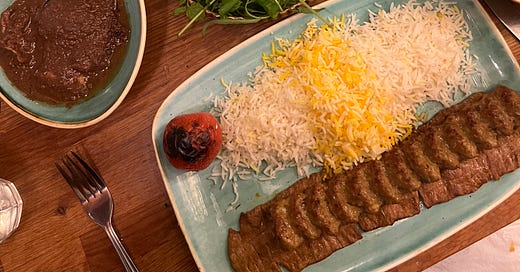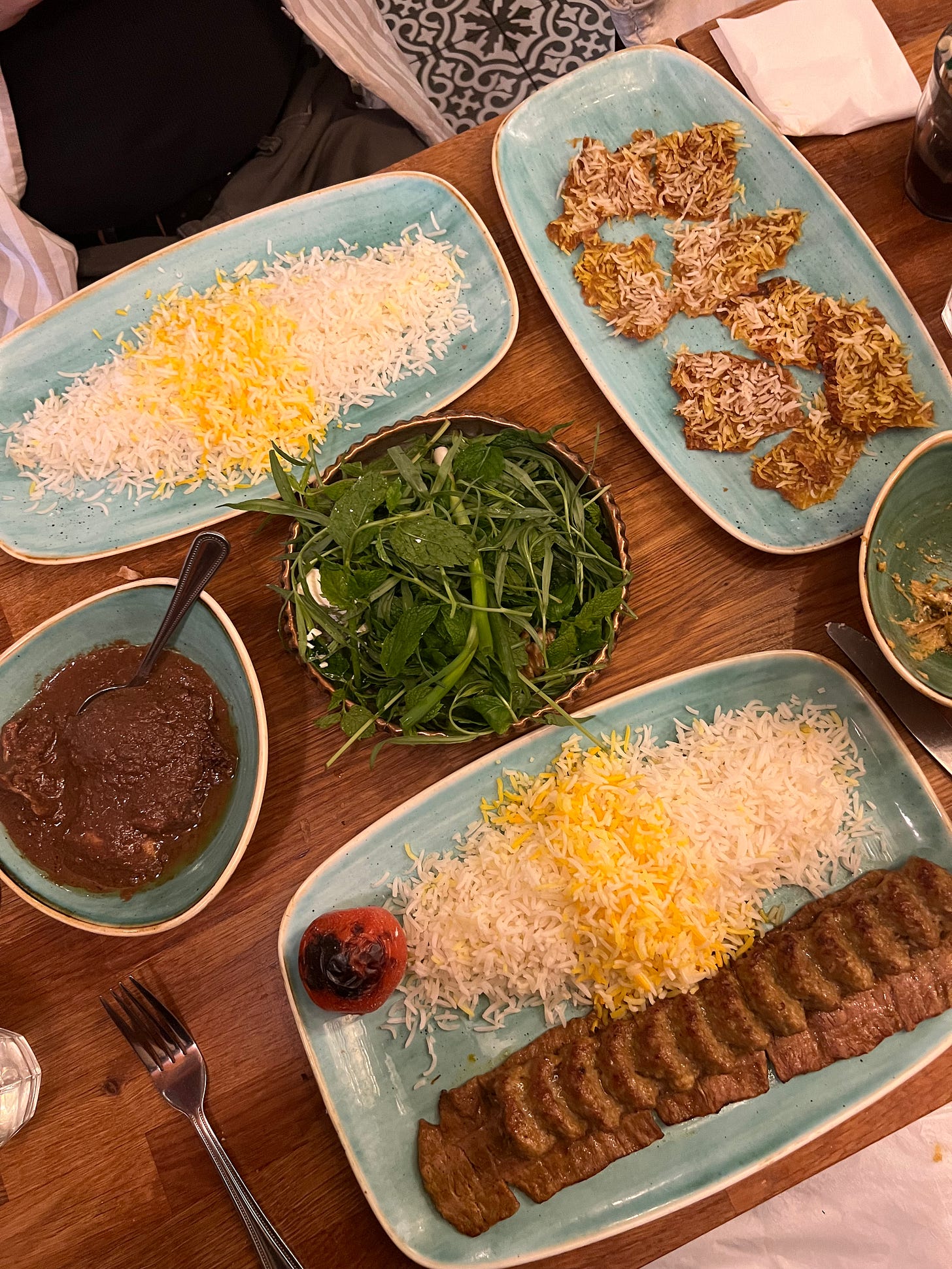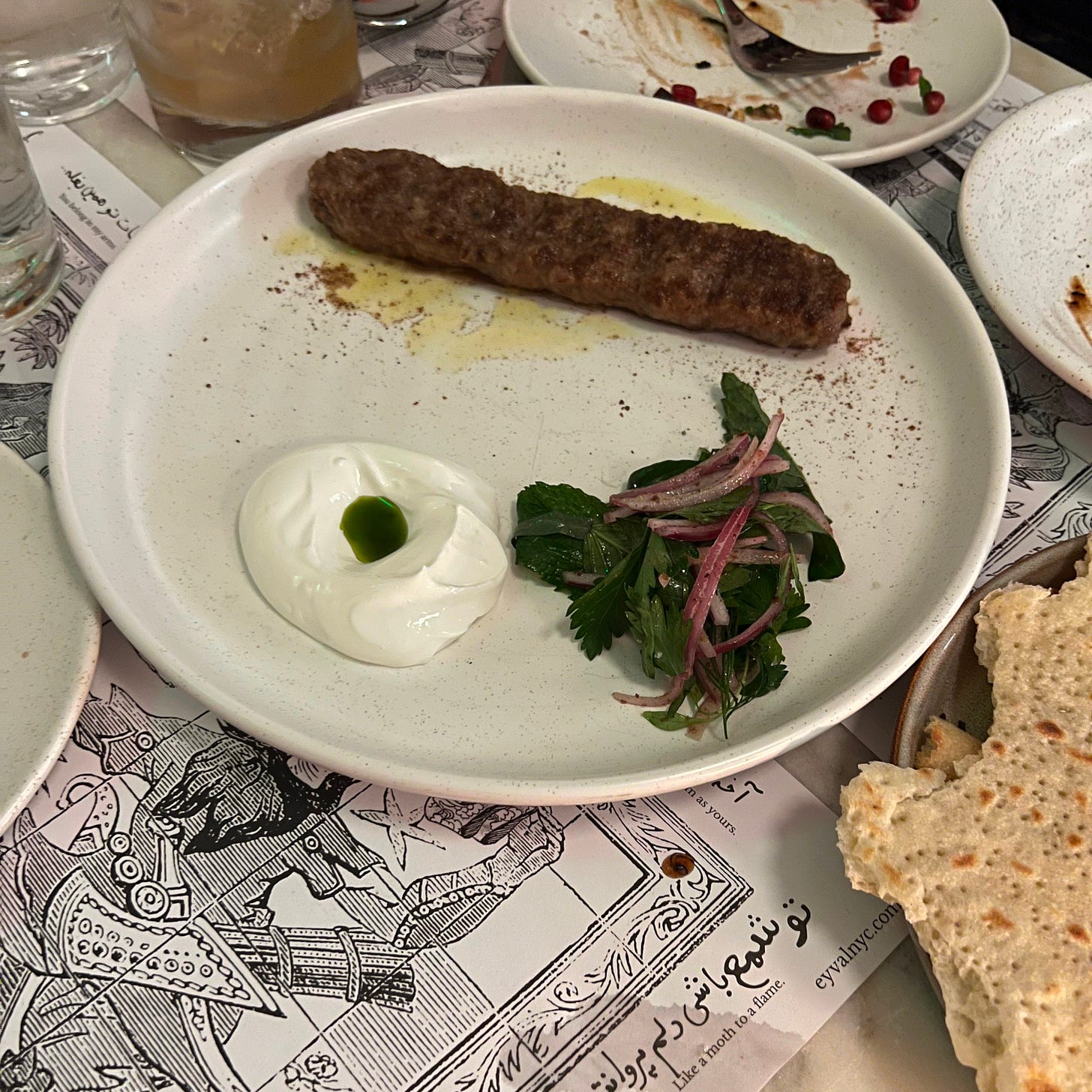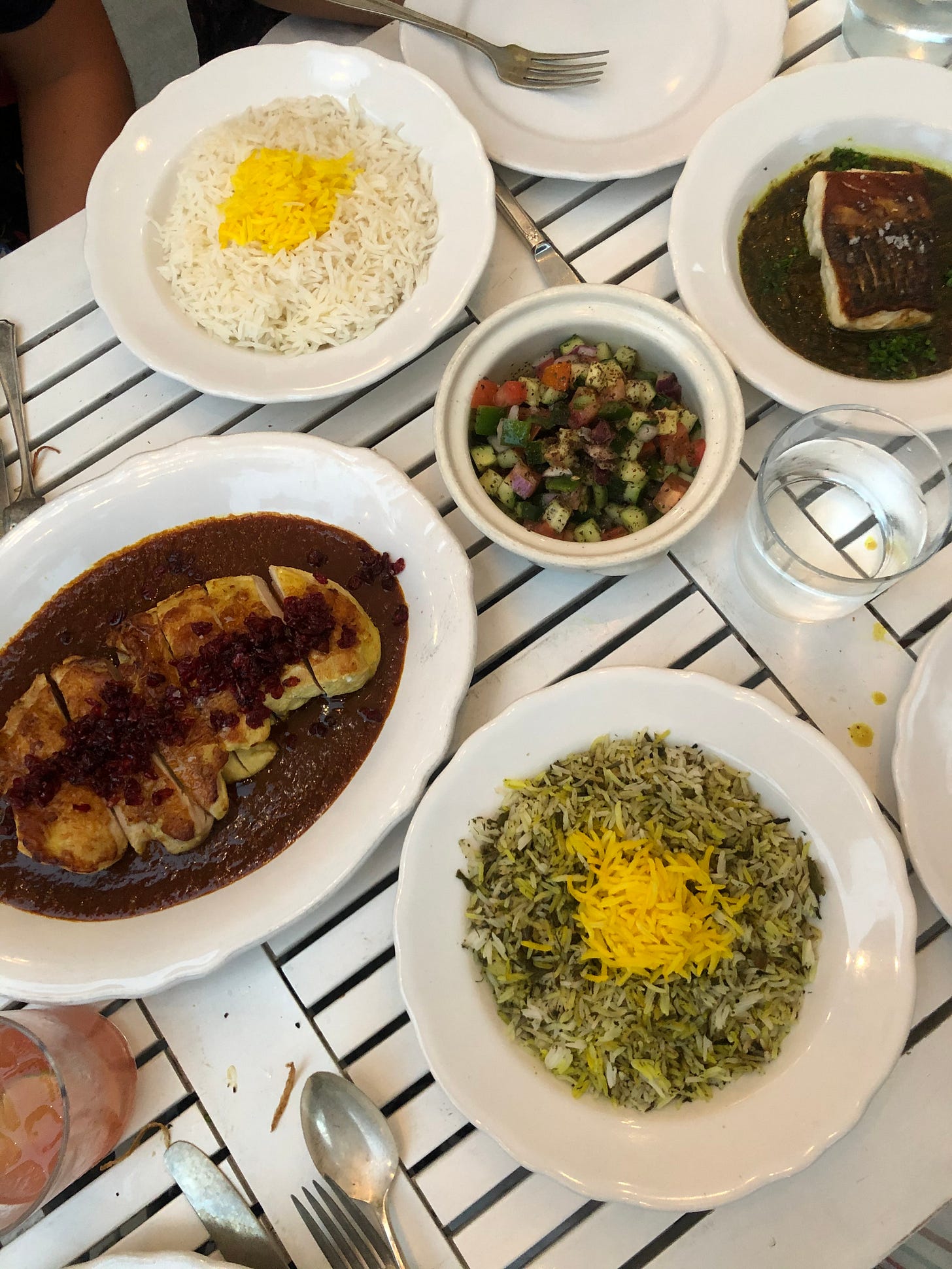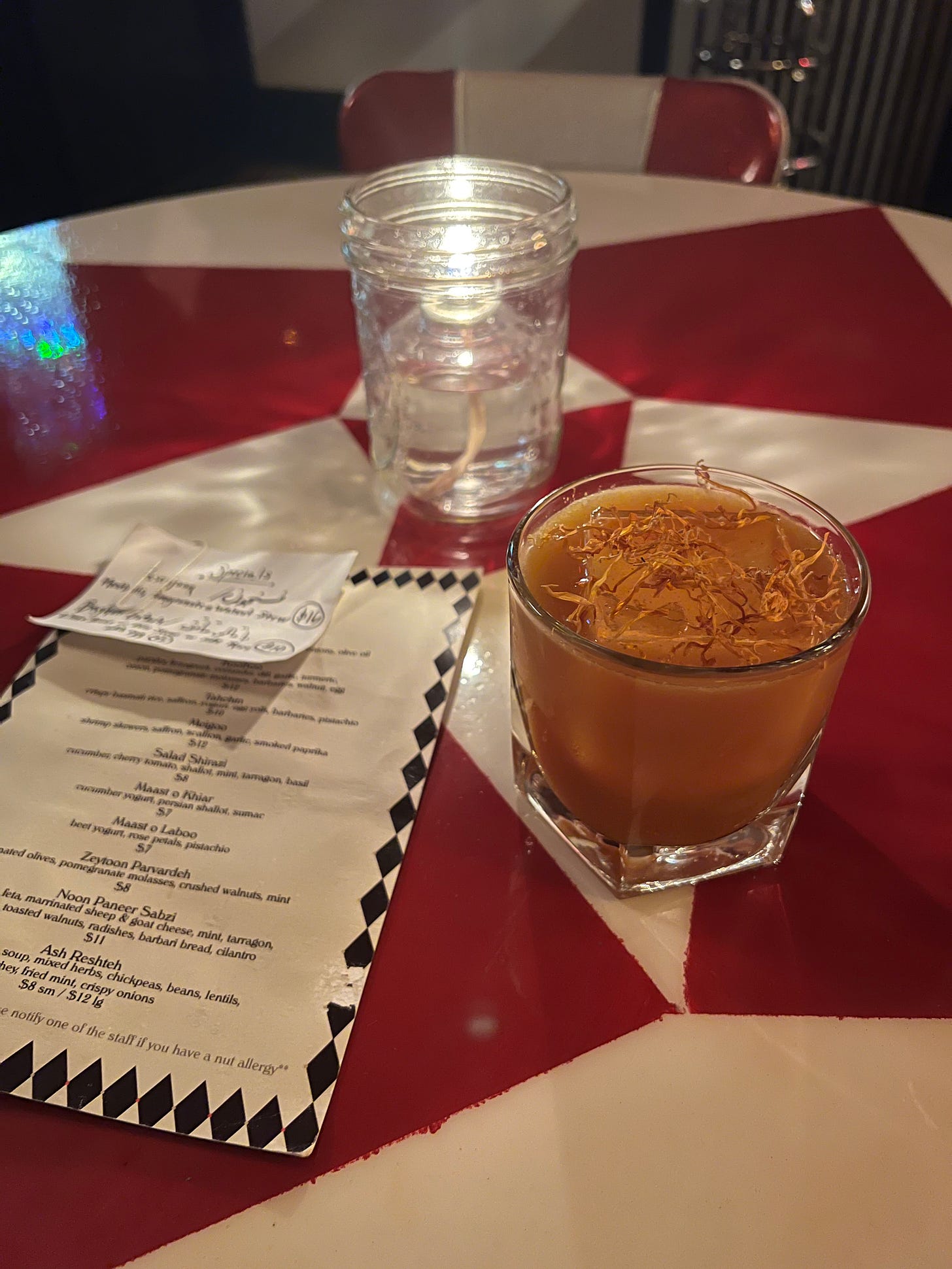where are all the good iranian restaurants in new york city?
Place like Sofreh and Eyval just can't seem to move past the kabob conundrum.
Until recently, the extent of Iranian cuisine available in the city was kabob. As a kid, my family would make the two hour drive down from Connecticut to eat at restaurants like Ravagh or Persepolis to get a taste of the food we couldn’t find at home. The dining rooms mimicked that of any other Iranian establishment in the country; framed photos of the ancient city of Persepolis, gaudy chandeliers, and classical Persian music playing over the sound system.
Kabob is the national dish of Iran and is basically the equivalent of a hamburger in America. The dish consists of marinated meats grilled over charcoals on long flat metal skewers. They’re usually served alongside a heaping mound of saffron rice with sides like must o musir (yogurt with shallots), must o khiar (yogurt and cucumber), and sabzi (a platter of fresh herbs). My favorite part is the piece of lavash (a type of flatbread) that’s nestled underneath the meat to soak up all the drippings.
Today, Iranian cuisine is coming more to the forefront of the city’s food scene, with new restaurants beginning to move past the usual kabob offerings. It started with Sofreh in Prospect Heights, then came Eyval in Bushwick, opened by Sofreh alum Ali Saboor, then Masquerade, a bar with Persian-inspired snacks. Now, it seems that there are two classifications of Iranian restaurants in the city: the old wave and the new. While it feels like Iranian food is finally having its moment in the spotlight, I find that neither group really captures the variety and breadth of the cuisine.
Places like Ravagh, Persepolis, and Shiraz churn out familiar favorites that have been popularized in America for decades. Sometimes, their menus include the more traditional stews that I crave like fesenjoon (braised chicken in a pomegranate walnut sauce) and gormeh sabzi (an herby lamb stew). They offer these items as a way cater to the Iranian-American diners, like my family, but usually the kitchens don’t have the resources to execute them well. Usually these stews are made in batches, probably earlier in the week, and reheated in the microwave to order.
Some of the newer destinations, like Sofreh and Eyval, have received critical acclaim for their contemporary approach, said to add depth to the shallow pool of Iranian restaurants in the city. As someone who grew up enveloped in the culture eating the food, I don’t agree with this sentiment. Don’t get me wrong: I was hopeful when these restaurants first opened. I set Resy notifies and corralled friends to come dine out with me. After dining at Sofreh and Eyval, I found the menus to read rather basic. Modern to them means serving traditional dishes on small plates, deconstructed — along the likes of the early 2000s gastronomy style of cooking.
At Eyval, I was served a single skewer of kabob koobideh where the usual ground beef was replaced with wagyu — an attempt to give a personalized spin on the classic. Yet somehow, even with all the fat from the wagyu, the final product was dry. I also ordered the tahdig, which is listed on the menu as it’s own dish. While it was presented beautifully, thin slices of potato layered on top of one another in a scallop pattern, the tahdig was soggy and didn’t have that crispy bite that’s integral to the dish. As for the rice, it was just fine. The granules were rather large, reminding me of the cheaper basmati rice, and the saffron essence was just that, an essence. If there’s anything that’s quintessential to Iranian cooking, and necessary to get just right as a Persian restaurant, it’s tahdig and rice. And unfortunately, Eyval missed the mark.
At Sofreh, I tried the half chicken with barberries, which was basically a deconstructed zereshk polo ba morgh (barberry rice with saffron chicken), served without the rice. The chicken was juicy and delicious, but it tasted just like any other saffron chicken I’ve had in my life. I also ordered the “catch of the day,” a small filet of fish with crispy skin served on top of an herby sauce akin to mahi ba sabzi — another popular dish that’s made its way to America. Both restaurants served barbari, a fluffy and slightly sweet Iranian flatbread that’s hard to come by in the city. Their versions are baked in an gas-fired stove and miss that wood-fired taste that makes barbari so good.
To me, all these dishes exist at the surface of Iranian cooking. The food is not taking a deeper dive by exploring regional cuisine or tapping into ancient dishes. Instead, places like Sofreh and Eyval are said to be doing something new and novel with the Iranian food, when in reality, their menus closely mirror the Iranian food that has been available in New York for so long.
Yes, they make small tweaks, like selling saffron rice on its own instead of including it with the kabob platter, or swapping out the meat in traditional stews for fancier options, like duck instead of chicken. But it seems like Sofreh and Eyval are implementing those generic, chef-y techniques that you see in countless restaurants in hopes of justifying the smaller portions with a higher price tags. (I walked away from both dinners with a bill that was around $200 a head).
Masquerade was the least offensive of the bunch. Sure, the website uses dreaded words like “contemporary” and “small plates” to describe itself. But it’s a categorization that I don’t necessarily agree with. The menu is limited, filled with snacks to munch on while you drink. Yet, surprisingly, it’s here where I’ve found iterations of the dishes that I love, and miss, so much: mini rounds of tahchin, slices of kuku sabzi — the kinds of food that I haven’t been able to find at either the old and new wave of restaurants in the city.
Maybe I resonate more with Masquerade because it doesn’t try too hard. The bar is situated under the overpass of the Marcy JMZ stop. You hear the rumbling of the train pulling into the station every few minutes. There’s a disco ball, tufted red leather seats, a DJ spins at night. It feels like a place that could have existed in Iran if the government wasn’t run by mullahs, or even a bar that might exist today, but in the country’s underground scene.
It actually reminds me of a restaurant I ate at the last time I was in Tehran, more than 10 years ago. The owner was covered in tattoos (which at the time, was frowned upon) and played rock music (a genre that’s illegal in Iran). The restaurant felt like a reprieve from the morality police-controlled streets of the city; an oasis where women loosened their scarves around their heads and people chatted freely.
This connection checks out, too. According to an interview in BK Mag, Masquerade owners Pouya Esghai and Siavash Karampour came to the US in 2010, seeking asylum as members of the Tehran-based band The Yellow Dogs. Once the band gained popularity outside the country, they fled. Through their bar, Esghai and Karampour are “focusing instead on manifesting the Tehran they’d love to see in the world — right here in Brooklyn.”
Masquerade taps into the subculture of Iran that very much exists to this day. They offer a window into Iran’s youth and the kinds of places they dine at. Unlike Sofreh and Eyval, Esghai and Karampour didn’t create a Iranian restaurant with the American patron in mind — they designed an establishment that they would’ve opened back home if the Islamic regime didn’t exist. The food at Masquerade is on its way to what I’m seeking out. It begins to go beyond the kabob, the salad-e-shirazi, but I’m still yearning for more.
Iran’s cuisine is vast. It’s region-specific, steeped in thousands of years of history with influence from surrounding countries. I want to see more regional cooking represented: the food from the northern Iranian Azerbaijan enclave, the Gulf coast, Isfahan, and Shiraz. I want to taste dishes from ancient Persia like abhgoosht. I want to see menus that go beyond the usual saffron and herb offerings, like shirin polo (a sweet rice with candied orange peels), bagali polo (rice with fava beans and lots of dill), reshteh polo (rice with noodles, dates, and warming spices), the list goes on.
Iranian restaurants in New York City have only scratched the surface. While Sofreh and Eyval broaden the city’s view of the cuisine beyond the typical kabob spots, there’s still more to explore. I understand the need to think about context, and how difficult it is to make a restaurant stand out in a place like New York, but sometimes authenticity is the best approach. Masquerade is beginning to understand that. It forgoes the noise around what’s trending and feeling the need to be sophisticated, instead diving into Iran’s underground movement. Now, I just need a menu that reflects it.
— Rayna


